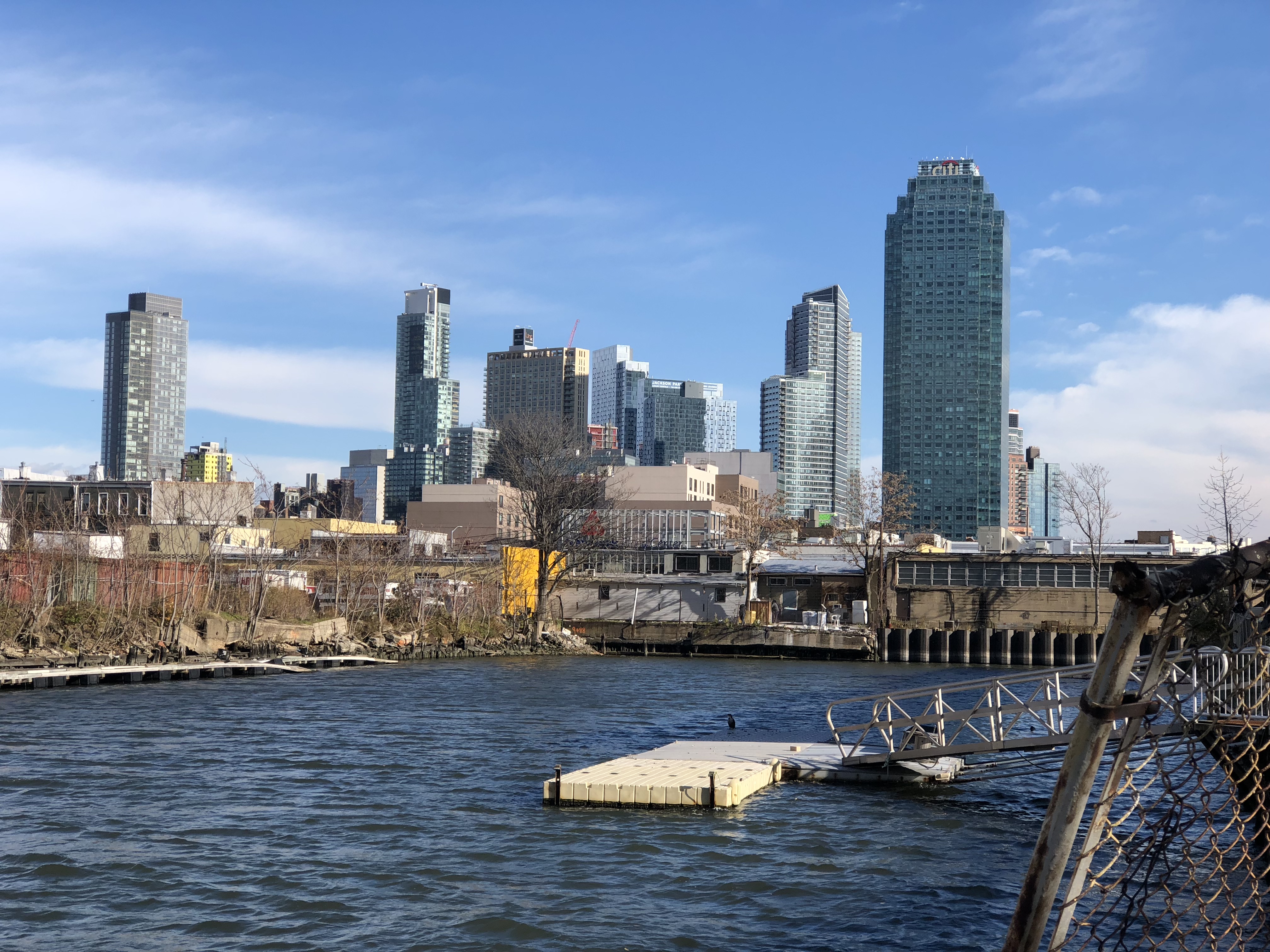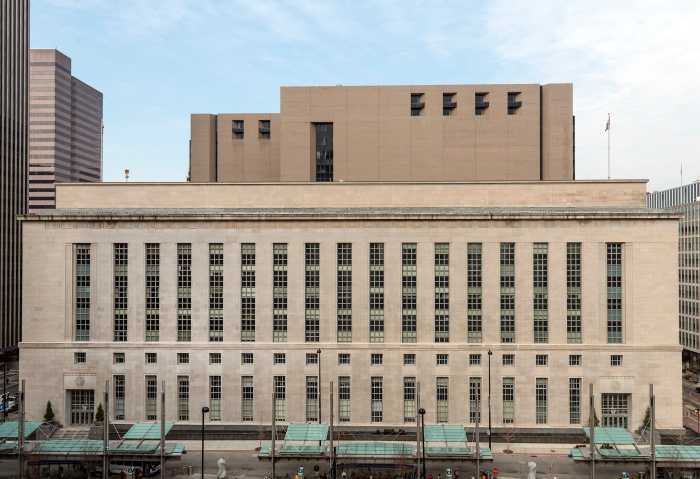
Part of Anable Basin today, where Amazon was planning on building its headquarters. (Photo: Nathaly Pesantez)
Feb. 24, 2020
Letter to the Editor: By Justin Potter (former state senate candidate) and Michael Guippone
We write in response to the February 6, 2020 letter from representatives of various organizations regarding the ongoing YourLIC development process for the Anable Basin site. Both of us have young children and live with our families in Long Island City and a short walk from the Anable Basin site, so we consider ourselves members of the community for which these organizations purport to speak.
We hope to remain here long term, but are worried about rising housing costs. We are also deeply concerned about the climate crisis. We see Anable Basin as an opportunity to address both matters.
We take issue with the statement made in the letter that, “most community members will oppose new private development—particularly the high-rise, mostly market rate residential towers and expensive office buildings that are likely to be built under the current scenario.”
On the contrary, we—community members—believe that it is in the best interest of people who live and work in Long Island City (and for New York City as a whole) for the Anable Basin site to include high-rise market rate residential towers, in addition to various other amenities that the community has been requesting through the YourLIC process.
The New York City metro region is in desperate need of housing. According to the NYC Department of Planning, the region’s “housing supply has not been keeping up with job growth in recent years.” That is, from 2009 to 2018, the region added 0.5 units of housing for every new job, down from 2.2 units per job from 2001 to 2008, and continuing down this path would “heighten affordability challenges and create headwinds to further business growth.”
Development of dense housing in the form of market rate residential towers in the Anable Basin site would do much to alleviate the extreme housing crunch facing this region.
The well-worn criticisms that market rate apartments would exacerbate the affordable housing crisis in this city are, in reality, dubious economics. Although it is likely true that any new market rate units will be expensive given the current scarcity of housing in New York City, according to economists at the W.E. Upjohn Institute (a private, not-for-profit, nonpartisan, independent research organization), because the families moving into the new market rate units “filter” out of older housing, these new units will lower demand for existing housing by freeing up apartments in below-median and bottom-quin-tile income tracts in the short term. New construction of market rate apartments has been shown to lower rents in the local area as well as the larger region.
Moreover, new housing at the Anable Basin site is good climate policy. Transportation is now the biggest source of America’s CO2 emissions. By contrast, one of Long Island City’s greatest assets is its accessibility to other areas of the City via the subway, bus, ferry or LIRR. Every increase in supply of housing in Long Island City means that more families can live here and use public transit to get around, as opposed to moving out of the city where those families might be forced to rely on private cars. Indeed, households in the suburbs have dramatically higher carbon footprints than households in the City, partly for this reason. To take just one example, the average annual household carbon footprint in Great Neck is 72.5 metric tons CO2 equivalent, compared to just 31.6 in Long Island City. Studies have shown that extensive sub-urbanization of metropolitan areas leads to net increases in carbon emissions. That is to say, a denser and more populated Long Island City would help combat climate change.
Development led by private developers with community input can be enormously successful. For example, Essex Crossing is a developer-led project that sought community input at the outset, much as YourLIC is doing now. The Essex Crossing development, which is near completion on the Lower East Side, creates 1,079 new apartments, more than half permanently designated for low- and middle-income tenants; plus community benefits like a new senior center, spaces for early childhood education programs and workforce development, a new cafe operated as a nonprofit job training site for local at-risk youth, and a large market.
The Anable Basin site presents a tremendous opportunity to build resources to serve our community for decades to come. No doubt a project as successful as Essex Crossing would be welcomed by many Long Island City residents.
Michael Guippone
Justin Potter
Response
Thank you, Justin Potter and Michael Guippone for your response about what kind of future development the community wants to see happen on the Anable Basin site (Two Residents Weigh in on YourLIC, 2/24/20). We disagree on the facts.
Your claim that building more market rate and luxury housing frees up older, cheaper housing for lower income renters has no basis in our present reality. According to a study of U.S. Census data between 2000 – 2016, median rent in and around the Anable Basin waterfront area increased over 125% — the highest in all of Queens. The same studio apartment going for $800 in 2000 would be $1800 by 2016, according to a study by the Office of Community Studies, Queens College.
This has brought on massive gentrification, due to a concentrated effort by the city to rezone and re-imagine LIC into the affluent and wealthy zone it is today. Since 2000, the median household income has risen 230 percent, from $53,000 to $123,000. It now take 18 years for an average household to save up enough money to afford an average condo in LIC, and that’s assuming prices in LIC will be comparable 18 years from now.
There is no evidence in the above data of the bountiful cheap housing for low-income families that Potter and Guippone claim- a claim based on a single study that does not include Long Island City in its research.
Similarly, the claim that “housing supply has not been keeping up with job growth” is contradicted by the data available for LIC. The city’s own Final Environmental Impact Study (FEIS) found that originally, developers and the city predicted LIC’s rezoning would see just 300,000 square feet of residential development across 300 new units. The zoning changes have instead produced 8.74 million square feet in new residential development, adding more than 10,000 new units to the area. That’s a lot of housing supply, and it’s a luxurious supply too expensive for most people to afford.
The claim that as more residents move here, they will be able to take advantage of our public transportation reveals a lack of experience with the 7 train. Average ridership in LIC has increased at seven-times the city-wide rate over the last six years. Public schools are similarly overcrowded– the original estimate required an additional 99 school seats by 2010, but by the time 2010 came around, zoning changes had brought 240 new students to the neighborhood. Just eight years later, more than 3,200 students have been added. Seven out of nine local elementary schools are now overcrowded, with one operating at more than 200% capacity.
None of this helps LIC become more resilient to climate change; quite the opposite. Yes, urban living carries a smaller individual carbon footprint than what you find in the suburbs- but that has nothing to do with LIC’s overcrowding issues, exacerbated by rampant development that makes it the fastest-growing neighborhood in the country. From rats, roaches and mold in NYCHA housing to backed-up sewers, Long Island City residents are already suffering from an strained infrastructure, yet the YourLIC developers are looking to build more in an area resting on the lowest point of the flood zone, with a resiliency plan that only protects their properties, allowing for a very minimal buffer zone around them.
There have been multiple community meetings held in LIC where the public has expressed their exasperation with the neighborhood’s over-saturated high-rise housing developments, especially along the waterfront. Meetings to gather community input is a worthwhile idea, but such meetings have been run solely by the developers (hoping to maximize their profit) which is a clear conflict of interest.
Potter and Guippone refer to Essex Crossing as an example of ideal city developments. While it is true that Essex provided some affordable senior housing, that occurred only after considerable community pushback — precisely what Potter and Guippone deride. If Queens’ residents are to receive any affordability in commercial or residential space on or near the Anable Basin development, it will be precisely because the community stands up and demands concessions that developers would never offer on their own. Even with those concessions, Essex Crossing is still renting a majority of “market-rate” units starting at a whopping $3750 per month– hardly affordable to a majority of Queens’ residents. Potter and Guippone are welcome to their opinion, but their perception is a perfect example of the Tale of Two Cities that LIC has become.
Sincerely,
Melissa Bieri, Long Island City Coalition
Ivan Contreras, Woodside on the Move
Manny Gomez, Sunnyside Artists
Patricia Dorfman, Small Town Confidential
Yvette Kemp, Justice for All Coalition
Brent O’Leary, Hunters Point Civic Association
Memo Salazar, Western Queens Community Land Trust
































